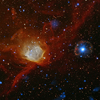CXC Home | Search | Help | Image Use Policy | Latest Images | Privacy | Accessibility | Glossary | Q&A
Tour of SXP 1062
Quicktime MPEG
The Milky Way galaxy has several small satellite galaxies very close to it. One of them is called the Small Magellanic Cloud. Astronomers using several telescopes - including the Chandra X-ray Observatory - spotted an unusual object in the SMC. The source is known as SXP 1062 and may be the first pulsar found within the remains of a supernova explosion. X-ray data from Chandra and XMM-Newton also show that SXP 1062 is rotating unusually slowly - about once every 18 minutes. In contrast, some pulsars are found to revolve multiple times per second, including most newly born pulsars. Scientists have determined the pulsar was born between ten and forty thousand years ago. While this may sound like a long time, it is a blink of an eye in astronomical terms. Therefore, it is a mystery why SXP 1062 has been able to slow down by so much, so quickly.
[Runtime: 01:12]
Quicktime MPEG
The Milky Way galaxy has several small satellite galaxies very close to it. One of them is called the Small Magellanic Cloud. Astronomers using several telescopes - including the Chandra X-ray Observatory - spotted an unusual object in the SMC. The source is known as SXP 1062 and may be the first pulsar found within the remains of a supernova explosion. X-ray data from Chandra and XMM-Newton also show that SXP 1062 is rotating unusually slowly - about once every 18 minutes. In contrast, some pulsars are found to revolve multiple times per second, including most newly born pulsars. Scientists have determined the pulsar was born between ten and forty thousand years ago. While this may sound like a long time, it is a blink of an eye in astronomical terms. Therefore, it is a mystery why SXP 1062 has been able to slow down by so much, so quickly.
[Runtime: 01:12]
(Credit: NASA/CXC/A. Hobart)
Return to SXP 1062 (December 20, 2011)



